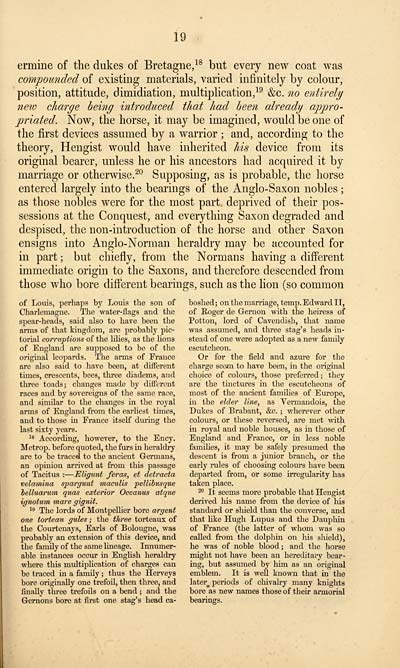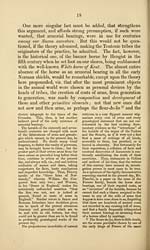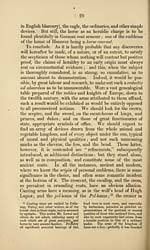Notices of the Ellises of England, Scotland, and Ireland, from the conquest to the present time
(359) Page 355
Download files
Complete book:
Individual page:
Thumbnail gallery: Grid view | List view

19
ermine of the dukes of Bretagne, 18 but every new coat was
compounded of existing materials, varied infinitely by colour,
position, attitude, dimidiation, multiplication, 19 &c. no entirely
neio charge being introduced that had been already appro-
priated. Now, the horse, it may be imagined, would be one of
the first devices assumed by a warrior ; and, according to the
theory, Hengist would have inherited his device from its
original bearer, unless he or his ancestors had acquired it by
marriage or otherwise. 20 Supposing, as is probable, the horse
entered largely into the bearings of the Anglo-Saxon nobles ;
as those nobles were for the most part deprived of their pos-
sessions at the Conquest, and everything Saxon degraded and
despised, the non-introduction of the horse and other Saxon
ensigns into Anglo-Norman heraldry may be accounted for
in part ; but chiefly, from the Normans having a different
immediate origin to the Saxons, and therefore descended from
those who bore different bearings, such as the lion (so common
of Louis, perhaps by Louis the son of
Charlemagne. The water-flags and the
spear-heads, said also to have been the
arms of that kingdom, are probably pic-
torial corruptions of the lilies, as the lions
of England are supposed to be of the
original leopards. The arms of France
are also said to have been, at different
times, crescents, bees, three diadems, and
three toads; changes made by different
races and by sovereigns of the same race,
and similar to the changes in the royal
arms of England from the earliest times,
and to those in France itself during the
last sixty years.
18 According, however, to the Ency.
Metrop. before quoted, the furs in heraldry
are to be traced to the ancient Germans,
an opinion arrived at from this passage
of Tacitus : — Eligunt feras, et detracta
velamina spargunt maculis pellibusque
belluarum quas exterior Oceanus atque
ignotum mare gignit.
19 The lords of Montpellier bore argent
one torteau gules ; the three torteaux of
the Courtenays, Earls of Bolougne, was
probably an extension of this device, and
the family of the same lineage. Innumer-
able instances occur in English heraldry
where this multiplication of charges can
be traced in a family ; thus the Herveys
bore originally one trefoil, then three, and
finally three trefoils on a bend ; and the
G-ernons bore at first one stag's head ca-
boshed; on the marriage, temp. Edward II,
of Roger de Gernon with the heiress of
Potton, lord of Cavendish, that name
was assumed, and three stag's heads in-
stead of one were adopted as a new family
escutcheon.
Or for the field and azure for the
charge seem to have been, in the original
choice of colours, those preferred ; they
are the tinctures in the escutcheons of
most of the ancient families of Europe,
in the elder line, as Verniandois, the
Dukes of Brabant, &c. ; wherever other
colours, or these reversed, are met with
in royal and noble houses, as in those of
England and France, or in less noble
families, it may be safely presumed the
descent is from a junior branch, or the
early rules of choosing colours have been
departed from, or some irregularity has
taken place.
20 It seems more probable that Hengist
derived his name from the device of his
standard or shield than the converse, and
that like Hugh Lupus and the Dauphin
of France (the latter of whom was so
called from the dolphin on his shield),
he was of noble blood ; and the horse
might not have been an hereditary bear-
ing, but assumed by him as an original
emblem. It is well known that in the
later_ periods of chivalry many knights
bore as new names those of their armorial
ermine of the dukes of Bretagne, 18 but every new coat was
compounded of existing materials, varied infinitely by colour,
position, attitude, dimidiation, multiplication, 19 &c. no entirely
neio charge being introduced that had been already appro-
priated. Now, the horse, it may be imagined, would be one of
the first devices assumed by a warrior ; and, according to the
theory, Hengist would have inherited his device from its
original bearer, unless he or his ancestors had acquired it by
marriage or otherwise. 20 Supposing, as is probable, the horse
entered largely into the bearings of the Anglo-Saxon nobles ;
as those nobles were for the most part deprived of their pos-
sessions at the Conquest, and everything Saxon degraded and
despised, the non-introduction of the horse and other Saxon
ensigns into Anglo-Norman heraldry may be accounted for
in part ; but chiefly, from the Normans having a different
immediate origin to the Saxons, and therefore descended from
those who bore different bearings, such as the lion (so common
of Louis, perhaps by Louis the son of
Charlemagne. The water-flags and the
spear-heads, said also to have been the
arms of that kingdom, are probably pic-
torial corruptions of the lilies, as the lions
of England are supposed to be of the
original leopards. The arms of France
are also said to have been, at different
times, crescents, bees, three diadems, and
three toads; changes made by different
races and by sovereigns of the same race,
and similar to the changes in the royal
arms of England from the earliest times,
and to those in France itself during the
last sixty years.
18 According, however, to the Ency.
Metrop. before quoted, the furs in heraldry
are to be traced to the ancient Germans,
an opinion arrived at from this passage
of Tacitus : — Eligunt feras, et detracta
velamina spargunt maculis pellibusque
belluarum quas exterior Oceanus atque
ignotum mare gignit.
19 The lords of Montpellier bore argent
one torteau gules ; the three torteaux of
the Courtenays, Earls of Bolougne, was
probably an extension of this device, and
the family of the same lineage. Innumer-
able instances occur in English heraldry
where this multiplication of charges can
be traced in a family ; thus the Herveys
bore originally one trefoil, then three, and
finally three trefoils on a bend ; and the
G-ernons bore at first one stag's head ca-
boshed; on the marriage, temp. Edward II,
of Roger de Gernon with the heiress of
Potton, lord of Cavendish, that name
was assumed, and three stag's heads in-
stead of one were adopted as a new family
escutcheon.
Or for the field and azure for the
charge seem to have been, in the original
choice of colours, those preferred ; they
are the tinctures in the escutcheons of
most of the ancient families of Europe,
in the elder line, as Verniandois, the
Dukes of Brabant, &c. ; wherever other
colours, or these reversed, are met with
in royal and noble houses, as in those of
England and France, or in less noble
families, it may be safely presumed the
descent is from a junior branch, or the
early rules of choosing colours have been
departed from, or some irregularity has
taken place.
20 It seems more probable that Hengist
derived his name from the device of his
standard or shield than the converse, and
that like Hugh Lupus and the Dauphin
of France (the latter of whom was so
called from the dolphin on his shield),
he was of noble blood ; and the horse
might not have been an hereditary bear-
ing, but assumed by him as an original
emblem. It is well known that in the
later_ periods of chivalry many knights
bore as new names those of their armorial
Set display mode to:
![]() Universal Viewer |
Universal Viewer | ![]() Mirador |
Large image | Transcription
Mirador |
Large image | Transcription
Images and transcriptions on this page, including medium image downloads, may be used under the Creative Commons Attribution 4.0 International Licence unless otherwise stated. ![]()
| Histories of Scottish families > Notices of the Ellises of England, Scotland, and Ireland, from the conquest to the present time > (359) Page 355 |
|---|
| Permanent URL | https://digital.nls.uk/95549921 |
|---|
| Description | A selection of almost 400 printed items relating to the history of Scottish families, mostly dating from the 19th and early 20th centuries. Includes memoirs, genealogies and clan histories, with a few produced by emigrant families. The earliest family history goes back to AD 916. |
|---|

